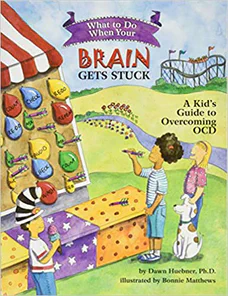What to Do When Your Brain Gets Stuck
A Kid's Guide to Overcoming OCD
Written by Dawn Huebner, Ph.D.
Illustrated by Bonnie Matthews
96 pages
•
Published 2007 (Magination Press)

Recommended Age Range: 1st through 5th grade, or even younger middle schoolers.
Publisher's Summary:
What To Do When Your Brain Gets Stuck guides children and their parents through the cognitive-behavioral techniques used to treat obsessive compulsive disorder. This interactive self-help book turns kids into super-sleuths who can recognize and more appropriately respond to OCD’s tricks. With engaging examples, activities, and step-by-step instructions, it helps children master the skills needed to break free from OCD’s sticky thoughts and urges, and live happier lives. This What-to-Do Guide is the complete resource for educating, motivating, and empowering children to work toward change.

Dr. Annie's Takeaways
Recommended for: This interactive workbook is best for kids and tweens with OCD who have clear compulsions (e.g., tapping, reassurance seeking, hand washing) and/or “not just right” OCD (e.g., straightening, erasing and rewriting, repeatedly changing socks) and who don’t have hoarding challenges. It could be completed chapter-by-chapter in therapy sessions, between sessions as therapy “homework,” or alongside therapy as a supplemental intervention. A caregiver with some understanding of OCD treatment might feel comfortable working through this workbook with their child without the support of therapy; however, most children with OCD will benefit most from being in therapy while completing this workbook (or soon after).
Would a child like it? OCD is often very confusing and painful for kids and adults, and this book lays out a clear path to understanding a child’s OCD and moving toward symptom reduction. It’s a little less fun than some of the What to Do workbooks, but it’s engaging enough, and for kids bothered by OCD, this book will be a relief.
Evidence-Based Practices:
Psychoeducation, Exposure and Response Prevention (ERP), Cognitive Restructuring
Tone: Instructive, encouraging
Story Quality: This workbook uses different activities and metaphors (e.g., a magician, a tantruming child, a clothes dryer) to help children and their parents to understand and manage OCD. It’s not quite as engaging as some of Dawn Huebner’s other books in the “What to Do” series (it’s an earlier one–I think they’ve gotten better over time), but it’s still quite effective. Kids with certain types of OCD (more on that below) will connect with the examples and activities, and it really does a nice job demystifying and destigmatizing OCD.
Illustrations: Black-and-white watercolor illustrations to accompany the text.
Representation: Children with different skin tones, hair, and genders are portrayed in the illustrations throughout the text. A few examples include mentions of Mom or of Dad.
Psychological Practices: This book is a great introduction to Exposure and Response Prevention (ERP)
, the gold-standard OCD treatment. It best addresses “not just right” OCD and OCD with clear compulsions (e.g., tapping, repeatedly changing socks, hand washing). It very briefly addresses Pure O (i.e., obsessive thoughts only) OCD, but this isn’t the best resource for supporting kids with this type of OCD. It’s also not a great choice for kids with hoarding concerns due to the initial introduction which assumes kids can sort out trash from important objects. The psychological concepts covered include: psychoeducation
about OCD, including why compulsions make OCD worse, fight or flight reactions to false alarms, “the maybe game”–i.e, attempts to obtain full certainty, and the not just right feeling; an introduction to a fear hierarchy, subjective units of distress (SUDS) scale, and exposure-driven habituation; an activity to help kids identify their OCD thoughts and urges; practice “talking back” to OCD; and a toolbox for resisting compulsions (e.g., walk away, change the ritual, do the opposite).
Concerns: The field is moving away from an emphasis on habituation in ERP and towards an emphasis on inhibitory learning, including anxiety tolerance and expectancy violation
s. In practice, treatment looks similar, and kids do often benefit from reassurance that their anxiety won’t last forever and will likely, in fact, decrease over time. I don’t think this is a reason not to use this book, but therapists may want to add in their own prompts to highlight kids’ ability to tolerate anxiety and any discrepancies between their feared outcome and what actually happened. Another small critique–at one point, the author mentions thinking of OCD as a “spoiled child” demanding candy at a grocery store. I don’t agree with the paradigm of children being spoiled; I prefer to think about them as being stuck with their caregivers in a pattern that isn’t working for anyone.
